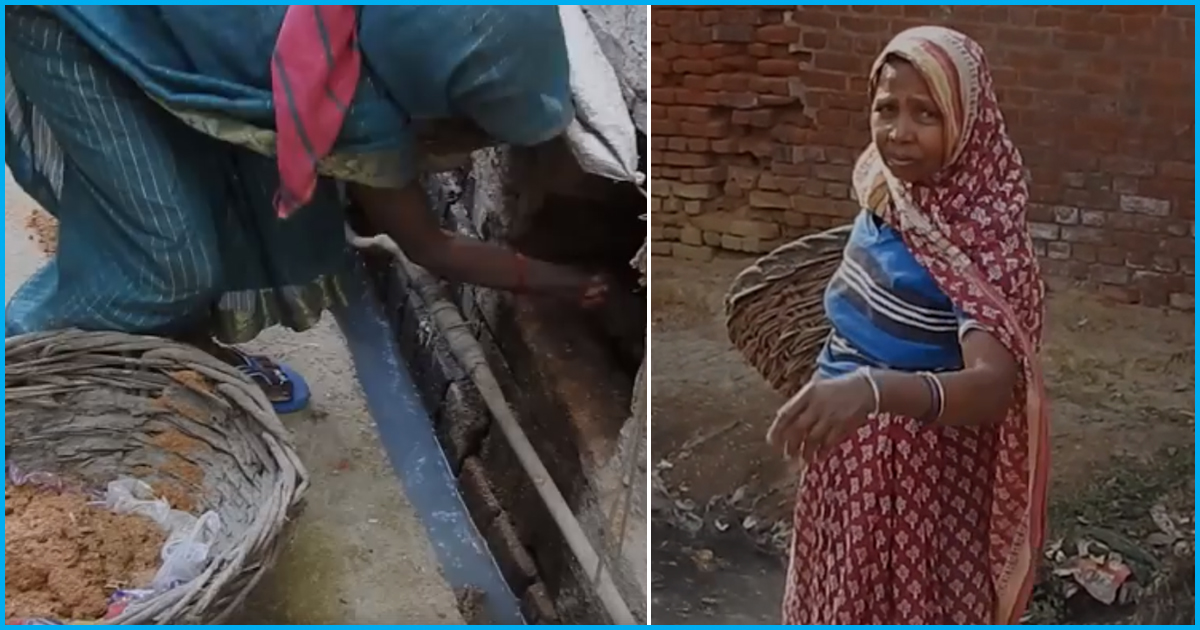
Cleaning Dry Toilets For 2 Rotis A Day: Evils Of Manual Scavenging
29 Jun 2018 9:25 AM GMT
The Wire, in a video, described the story of Shanti who has been cleaning dry toilets for the past five years. Every morning, Shanti Devi, a resident of Mainpuri in Uttar Pradesh begins cleaning toilets, and in return, she just gets a couple of rotis.
After 25 Years of Broken Promises, India is Counting its Manual Scavengers Again
#GRIT: After 25 Years of Broken Promises, India is Counting its Manual Scavengers AgainRead more: https://bit.ly/2JSGDsr
Posted by TheWire.in on Wednesday, June 20, 2018
Even though Shanti tried to quit the work that she has been doing, she was forced to return to it after failing to secure an alternative means of livelihood. Speaking to The Wire, she said that she gets 10kgs of grains every six months for her work.
On April 20, 2018, many men and women like Shanti who are presently engaged with manual scavenging gathered at the tehsil office of the district’s Kishni town to register themselves as manual scavengers.
The media has increasingly been covering reports of manual scavengers suffocating to death in septic tanks and sewage holes. However, a burning issue which continues to slip our minds is the government’s apathy towards home and community-based manual scavenging. A large number of Dalit women are subjected to such caste-based discrimination.
In 1993, after a long struggle, “The Prohibition of Employment as Manual Scavengers and Their Rehabilitation Act, 2013” was passed which outlaws the employment of manual scavengers, construction of insanitary latrines, and provides for rehabilitation of manual scavengers with one-time cash assistance, scholarship for their children, and a residential plot with financial assistance for constructing a house.
Identifying Manual Scavengers
However, one important component of the law is to identify manual scavengers across the country. However, many states deny the existence of the practice altogether. In a bid to identify and hopefully eradicate the evil practice, the Ministry Of Social Justice And Empowerment has once again started counting the number of manual scavengers.
According to The Indian Express, an inter-ministerial task force has identified 53,236 people involved in manual scavenging in India and this projects a dismal condition since it is just the data from 121 districts out of India’s 600 districts. Notably, UP accounts for the highest number of manual scavengers in the country.
The task force is expected to submit its final tally on the National Survey of Manual Scavengers by the end of June while states like Bihar, J&K, Jharkhand, Karnataka, Telangana and West Bengal are yet to participate in the survey.
According to a report tabled in the Rajya Sabha in 2016, 22,327 lose their lives every year due to manual scavenging. The Supreme Court had directed authorities to pay a sum of Rs 10 lakh to the affected families; although reports suggest that the families had received only about Rs 60,000.
Why does manual scavenging continue in India?
However, manual scavenging still survives in parts of India without proper sewage systems or safe faecal sludge management practices. It is most prevalent in Gujarat, Madhya Pradesh, Uttar Pradesh, and Rajasthan. Moreover, the Prohibition of Manual Scavengers Act has not been implemented properly as manual scavenging continues and manual scavengers continue to die.
An estimated 62,000 million litres per day (MLD) of sewage is generated in urban areas; only about 30% of this waste goes through treatment plants. The rest is dumped into rivers, seas, and wells. Furthermore, 85 million people in urban India lack adequate sanitation. These numbers are only for urban India; numbers for rural India are worse.
As per the 2011 Socio-Economic survey, there are 1,67,487 households that get employment by manual scavenging in rural areas.
The major reason for the continued existence of manual scavenging is the existence of unsanitary latrines. These are latrines without water, where the excreta must be physically removed.
Another major contributor to the continued existence of this crime is the Indian Railways. Many train carriages have toilets dropping the excreta from trains on the tracks; scavengers are employed to clean these tracks manually.
The Logical Indian take
Manual scavenging is modern-day slavery. That it continues in the 21st century India is something that should horrify and outrage us all. At the same time, it is important that we ensure that further deaths due to manual scavenging do not occur.
The Prohibition of Manual Scavengers Act should be implemented with more efficiency; the governments at the centre and the states should establish that manual scavenging will not be tolerated and lawbreakers will be punished. Also, alternate means of employment should be generated for the impoverished people who are forced to become manual scavengers due to lack of alternatives means of livelihood.
 All section
All section













